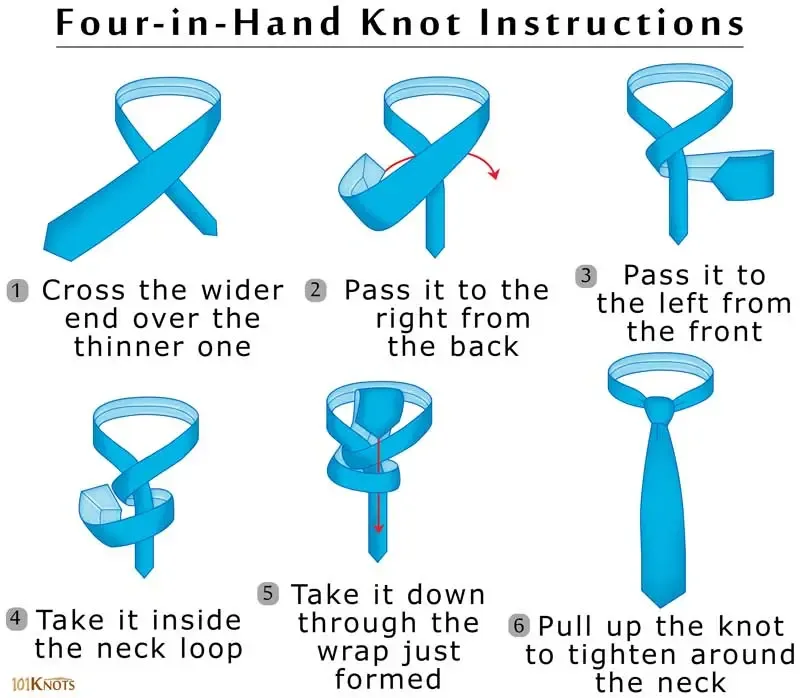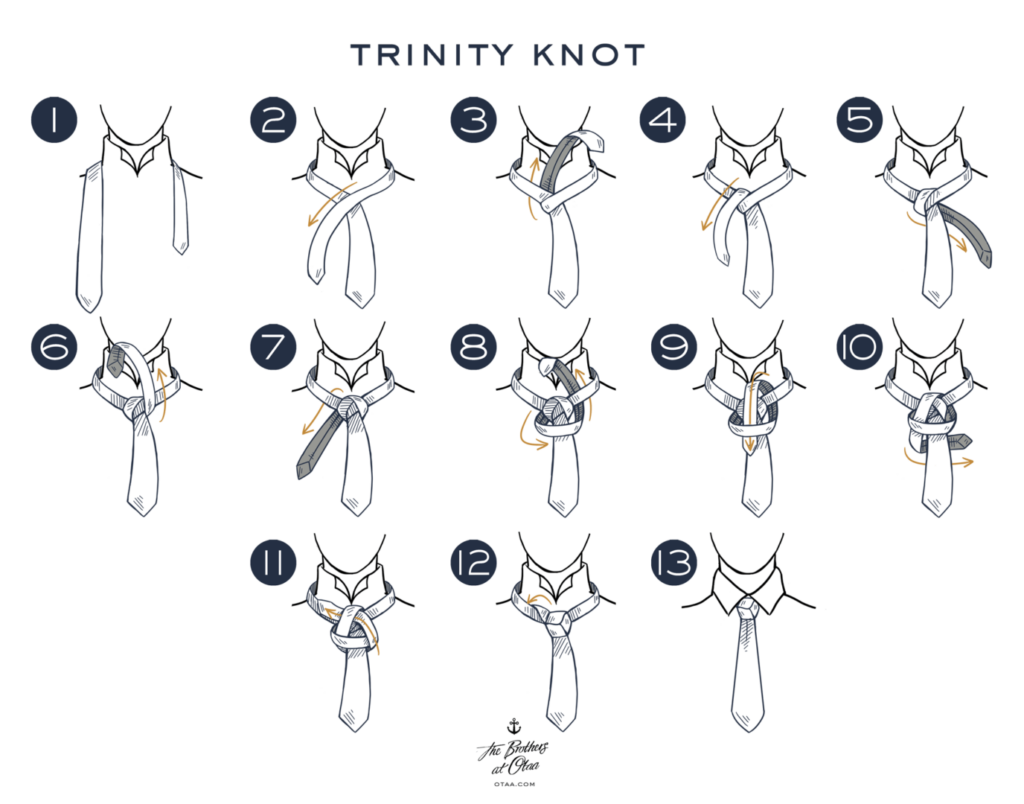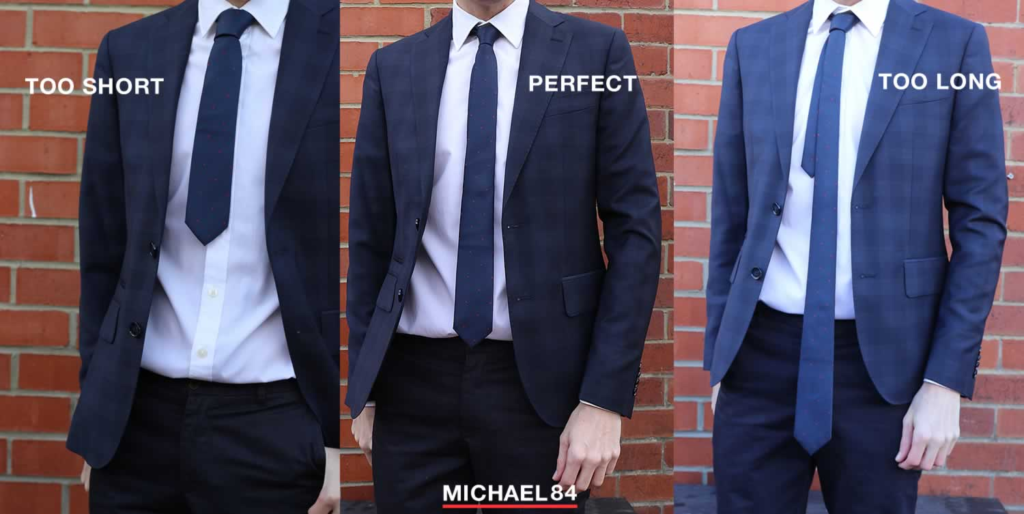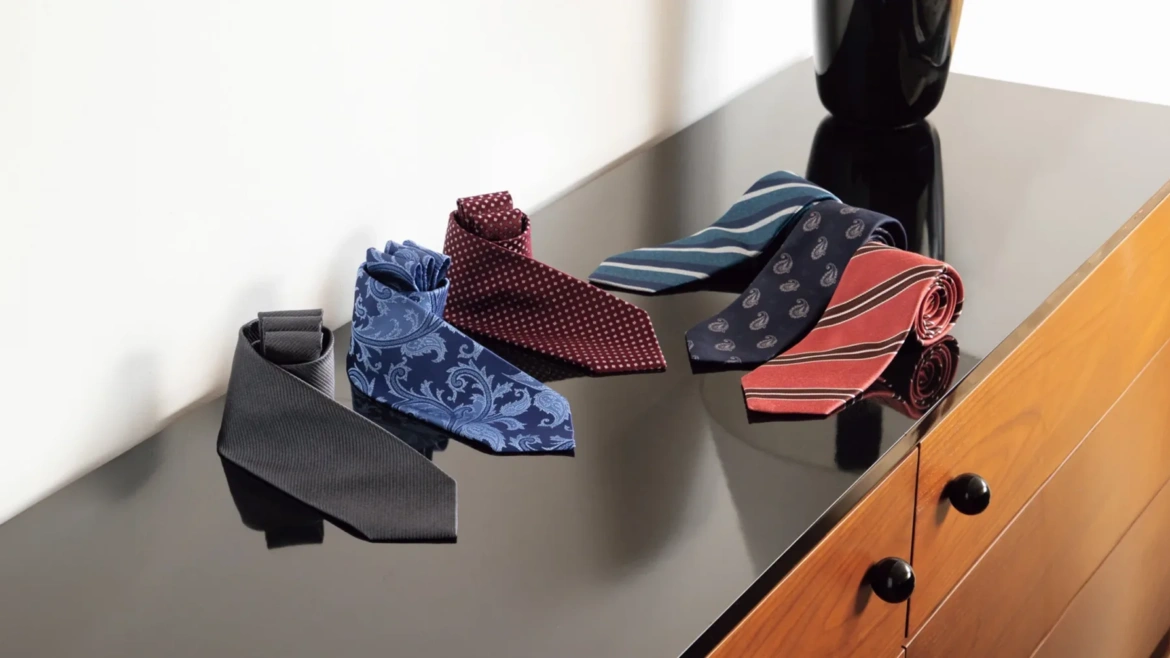Choosing the right tie knot is not just about practicality; it’s an art form that can significantly impact your appearance and the message you convey. With different tie knot styles available, each type serves a unique purpose, complementing different outfits and occasions. Tying a tie correctly ensures that you present yourself in the best possible light, whether at a business meeting, a formal event, or a casual gathering. This guide explores different men’s tie knot types, providing you with the essential knowledge to elevate your style. From classic choices like the Four-in-Hand to more intricate designs like the Windsor, understanding how to master these knots is crucial for anyone looking to enhance their professional and personal presence. Let’s delve into the art of necktie knots and discover how each can sharpen your style and confidence, ensuring you always make the right impression.
Tie Knot Basics
Tie knots are essential elements of a man’s wardrobe that can convey professionalism and attention to detail. Knowing how to select and tie the appropriate knot for the occasion isn’t just about style—it’s about making a personal statement. From the classic Windsor to the modern Eldredge, each knot has its significance and setting where it shines the most.
Components of a Tie:
A tie consists of several parts: the blade (wide end), the tail (narrow end), the neckband, and sometimes a keeper loop. The thickness, length, and width of the tie can influence which knot will look best. For example, a thicker fabric might be more suitable for a robust Full Windsor, whereas a slimmer tie pairs well with a Four-in-Hand knot.
Common Materials and Styles:
Ties come in a variety of materials, including silk, wool, polyester, and cotton, each offering different textures and weights. The choice of material can affect the knot’s appearance and ease of tying. For instance, a silk tie, often seen in vibrant colors like a classic red necktie, lends itself well to a polished, smooth knot. Meanwhile, patterned or textured ties, such as those with necktie clips or unique weaves, can add an extra element of interest and style to a basic men’s tie knot.
These fundamentals provide the groundwork for anyone aiming to master the art of tying a tie, ensuring that every man with a necktie can step out in confidence and style.
Necktie Knots for Professional Settings
1. Four-in-Hand Knot:
The 4 in hand tie knot is also known as the Sliding knot and is the quintessential choice for most business settings due to its simplicity and elegance. Ideal for men who prefer a slim, elongated look, this knot works well with most shirt collars and is particularly suited for standard office wear. How to tie a Sliding knot: Start by draping the tie around your neck, ensuring the wide end is longer. Cross the wide end over the narrow end, wrap it underneath, and bring it across again. Pull it through the loop around your neck and slip the wide end through the knot you’ve formed. Tighten and adjust the knot to sit neatly between your collar.

2. Half Windsor Knot (Single Windsor Tie Knot):
A versatile, symmetrical knot that provides a more formal appearance than the 4 in hand tie knot but is less bulky than the Full Windsor. It’s ideal for presentations, job interviews, and situations where a touch of formality is needed without appearing overly formal. How to tie a necktie half Windsor: Place the tie around your neck, the wide end longer than the narrow end. Cross the wide end over the narrow and bring it up through the neck loop. Bring it down and pass it around the back of the narrow end. Cross it over the front and pull up through the neck loop again. Thread the wide end through the loop you’ve created in the front, tighten, and adjust the triangle formation for symmetry. How to tie a necktie half Windsor is quite simple.

3. Full Windsor Knot:
Known for its wide, triangular symmetry, the Full Windsor is perfect for very formal business settings, such as executive meetings or formal events. It pairs best with shirts that have wide-spread collars. How to tie a necktie Windsor: Begin with the wide end of the tie on the right and extend it about 12 inches below the narrow end. Cross the wide end over the narrow end and bring it up through the neck loop from underneath. Bring it down and pass it behind the narrow end to the left, then bring it up and through the neck loop again, pulling it down to the right. Cross the wide end over the front to the left and bring it up through the neck loop from underneath. Finally, pull the wide end through the knot in front, tighten gently and center the knot.

Knots for Social Events
When attending social events, choosing the right necktie knot can elevate your style and make a lasting impression. Below, we explore three popular necktie knots that are perfect for various occasions: the Pratt Knot (also known as the Shelby Knot), the Bow Tie Knot, and the Eldredge Knot. Each has its own unique flair and is suitable for different types of gatherings.
1. Pratt Knot (Shelby Knot)
The Pratt Knot, or Shelby Knot, is a classic and versatile tie knot that works well with both formal and semi-formal attire. It’s slightly asymmetrical and lies flat against the collar, making it an excellent choice for those who want something more distinctive than a basic tie knot but not too flashy.
Suitable Occasions: Business meetings, weddings, cocktail parties, and other semi-formal events.

Tying Instructions:
1. Begin with the wide end on your right side, slightly longer than the narrow end.
2. Cross the wide end over the narrow end.
3. Bring the wide end under the narrow end and up through the neck loop.
4. Pass the wide end across the front of the knot.
5. Pull the wide end down through the loop at the neck again.
6. Tuck the wide end through the dimple behind the knot.
7. Adjust and tighten as needed.
If you’re wearing a sage green necktie, this knot adds a sophisticated touch to your ensemble, especially when paired with a navy or charcoal suit.
2. Bow Tie Knot
A bow tie is a timeless accessory that exudes elegance and charm. Whether tied in silk or cotton, it’s an ideal choice for formal events where you want to stand out from the crowd.
When to Wear a Bow Tie: Black-tie events, proms, formal dinners, and weddings.

Simple Guide to Tying a Bow Tie:
1. Start with one end slightly longer than the other.
2. Cross the longer end over the shorter end and bring it around to form a simple knot.
3. Fold the longer end horizontally to create a bow shape.
4. Hold the folded end with one hand while looping the shorter end over the center of the bow.
5. Tuck the shorter end behind the loop and pull it through to form the second bow.
6. Adjust the bows until they’re symmetrical and snug.
3. The Eldredge Knot
This is a showstopper among different tie knot styles. Known for its intricate design and bold appearance, it’s perfect for those who aren’t afraid to make a statement.
This flashy knot features multiple loops and textures, creating a visually appealing pattern that draws attention.
When to Wear It: Creative galas, art openings, themed parties, or any event where you want to express individuality.

How to tie an Eldredge Knot
1. Start with the wide end on your right, longer than the narrow end.
2. Cross the wide end over the narrow end and bring it underneath to form a basic knot.
3. Wrap the wide end around the front of the knot twice, forming two loops.
4. Pass the wide end through the neck loop from beneath, pulling it back toward you.
5. Create another loop with the wide end and pass it through the first loop created earlier.
6. Feed the wide end through the newly formed loop and adjust carefully.
7. Tighten the knot and ensure symmetry.
Knots for Special Occasions
When it comes to special occasions, choosing the right tie knot type can make all the difference in your overall look. Below, we explore three unique men’s tie knot kinds that are perfect for making a statement at important events: the Balthus Knot, the Trinity Knot, and the Atlantic Knot. Each knot has its distinct style and is suited for specific settings.
1. Balthus Knot
The Balthus Knot is one of the most distinctive and elegant necktie knots in the world of menswear. Its asymmetrical design and wide, triangular shape make it an excellent choice for those looking to add a touch of sophistication to their formal attire.
Named after the artist Balthus, this knot was popularized by French fashion enthusiasts and is known for its artistic flair.
Perfect Settings: Ideal for black-tie events, formal weddings, or any occasion where you want to stand out with a refined yet unconventional look.

How to Tie It:
1. Start with the wide end on your left, longer than the narrow end.
2. Cross the wide end over the narrow end and bring it underneath to form a simple knot.
3. Wrap the wide end around the front of the knot twice, creating two loops.
4. Pass the wide end through the neck loop from beneath, pulling it back toward you.
5. Tuck the wide end through the loop created by the first wrap.
6. Adjust the knot carefully to achieve the signature asymmetrical shape.
This knot works beautifully with silk ties in rich colors or patterns, adding a touch of elegance to your ensemble.
2. The Trinity Knot
This is a classic yet modern knot that strikes a balance between simplicity and sophistication. Its triangular shape and clean lines make it a versatile choice for both formal and semi-formal occasions.
This knot is named after its resemblance to the Christian symbol of the Holy Trinity, with its three distinct loops forming a symmetrical triangle.
Ideal Events: Perfect for business meetings, charity galas, and other professional or semi-formal gatherings.

Tying the Trinity Knot:
1. Begin with the wide end on your right, slightly longer than the narrow end.
2. Cross the wide end over the narrow end and bring it underneath to form a basic knot.
3. Wrap the wide end around the front of the knot once, creating a loop.
4. Pass the wide end through the neck loop from beneath, pulling it back toward you.
5. Tuck the wide end through the loop created by the first wrap.
6. Adjust the knot to ensure symmetry and tighten as needed.
This knot type is particularly effective with solid-colored ties, such as navy blue or burgundy, giving your outfit a polished finish.
3. The Atlantic Knot
The Atlantic Knot is an unconventional and playful choice that adds a modern twist to traditional menswear. Its irregular shape and layered loops make it a standout option for those who want to experiment with their style.
How and When to Wear It: Best suited for creative events, themed parties, or casual celebrations where you want to express individuality. Avoid wearing it to ultra-formal occasions, as its asymmetry may clash with the dress code.

Tying Instructions:
1. Start with the wide end on your left, longer than the narrow end.
2. Cross the wide end over the narrow end and bring it underneath to form a basic knot.
3. Wrap the wide end around the front of the knot twice, creating two loops.
4. Pass the wide end through the neck loop from beneath, pulling it back toward you.
5. Create another loop with the wide end and pass it through the first loop created earlier.
6. Feed the wide end through the newly formed loop and adjust carefully.
Tips for Choosing the Right Knot
Selecting the right men’s tie knot types knot is about more than just personal preference—it involves considering factors like your face shape, shirt collar type, tie material, and the occasion itself. Below, we break down these elements to help you make an informed decision that enhances your overall look.
Face Shape and Collar Type
Your face shape and shirt collar can significantly influence which tie knot suits you best. Here’s how to align them:
Round Faces: Opt for wider knots like the Windsor or Half Windsor to create a more angular appearance. Pair these with spread collars or cutaway collars to add balance.
Oval Faces: Lucky you! This versatile face shape works well with almost any knot. However, medium-sized knots like the Four-in-Hand or Pratt are particularly flattering. A semi-spread collar complements this look.

Long Faces: Choose smaller knots such as the Four-in-Hand or Simple Knot to avoid elongating your face further. Pointed collars or button-downs work best here.
Square Faces: Go for asymmetrical knots like the Balthus or Eldredge to soften sharp angles. A spread collar or club collar will enhance this effect.
Tip: Always ensure the knot matches the width of your collar points—if your collar is wide, go for a larger knot; if it’s narrow, stick to something smaller.
Tie Material
The texture and weight of your tie also play a role in determining which knot to use. Different materials behave differently when tied, so consider the following:
– Silk Ties: These lightweight ties are perfect for classic knots like the Four-in-Hand or Half Windsor. Silk drapes beautifully and creates smooth, polished results.
– Wool or Cotton Ties: Heavier materials benefit from bulkier knots like the Full Windsor or Kelvin Knot. These fabrics hold their shape better and won’t look too flat or limp.
– Textured or Patterned Ties: For ties with bold patterns or textures, choose simpler knots (e.g., Four-in-Hand) to prevent overwhelming the overall look. Conversely, solid-colored ties allow you to experiment with more intricate knots like the Eldredge or Trinity.
Tip: Avoid pairing very thick ties with small knots, as they may appear disproportionate. Similarly, delicate ties might get lost in large, complex knots.
Occasion Suitability
Matching your knot to the formality and nature of the event ensures your outfit feels appropriate and polished. Here’s a guide:
– Casual Events: Stick to simple, understated knots like the Four-in-Hand or Simple Knot. These knots pair well with casual shirts and lightweight ties, making them ideal for relaxed settings.
– Business Meetings: The Pratt Knot or Half Windsor is a safe choice for professional environments. They strike a balance between elegance and practicality without drawing unnecessary attention.
– Formal Occasions: Larger, more elaborate knots like the Full Windsor or Atlantic Knot are perfect for black-tie events. Use silk ties in darker colors to complement the formal atmosphere.
– Creative or Themed Events: Unconventional knots like the Eldredge or Balthus shine at artistic or themed gatherings. Don’t be afraid to mix bold patterns or unexpected colors to match the vibe.
Tip: Consider the dress code before selecting your knot. If unsure, err on the side of simplicity—you can always step up your game next time!
Common Mistakes to Avoid
Even the most stylish outfits can be undermined by common mistakes in tie length, style mismatching, or poor knot execution. Below, we address these pitfalls and provide actionable tips to help you achieve a polished and professional appearance every time.
Incorrect Tie Length: How to Ensure the Tie Hangs Correctly
One of the most noticeable errors is an improperly sized tie. A tie that’s too long or too short can detract from your overall look. Here’s how to get it right:
– Ideal Length: The bottom tip of your tie should reach the top of your belt buckle when standing straight. This ensures balance and proportion.
– Adjusting for Different Heights: If you’re taller, opt for longer ties (often labeled “long” or “extra-long”). For shorter individuals, standard-length ties usually suffice, but avoid excessively long ones that hang below the waistband.

– Pre-Tied Ties: Avoid pre-tied or clip-on ties, as they rarely offer the same level of customization and often appear less authentic.
Tip: Always try on your tie with your shirt fully buttoned to ensure the length is correct before heading out.
Mismatching Style and Occasion: Guidelines to Prevent Style Errors
Wearing the wrong tie style for the occasion can make even the best-dressed person look out of place. Follow these guidelines to stay appropriate:
– Casual Settings: In relaxed environments like coffee meetings or casual dinners, go for thinner, simpler knots like the Four-in-Hand or Simple Knot. Use lightweight materials such as cotton or linen for a laid-back vibe.
– Business Professional: Stick to classic knots like the Pratt or Half Windsor for office settings. These knots convey reliability and professionalism without being overly flashy. Solid colors or subtle patterns work best here.
– Formal Events: Black-tie affairs call for larger, more intricate knots like the Full Windsor or Eldredge. Opt for silk ties in dark hues to complement tuxedos or formal suits.
– Creative Gatherings: For artistic or themed events, feel free to experiment with bold patterns, unconventional knots (like the Balthus), or textured fabrics. Just ensure the tie still fits within the broader dress code.
Tip: When in doubt, aim for understated elegance rather than over-the-top flair. It’s easier to add personality later than to tone down an outfit that’s too extravagant.
Poor Knot Execution: Tips to Avoid Sloppy Knots and Ensure a Sharp Appearance
A poorly tied knot can ruin an otherwise impeccable ensemble. Here’s how to avoid this common issue:
– Start with Proper Alignment: Begin with the wide end of the tie slightly longer than the narrow end. This ensures symmetry throughout the tying process.
– Practice Makes Perfect: Some knots, like the Eldredge or Trinity, require practice to master. Dedicate time to learn each step carefully, and don’t rush through the process.
– Tighten Gradually: Once the knot is formed, gently tighten it by pulling upward on the narrow end while holding the knot steady. Avoid yanking too hard, which can distort its shape.
– Check Symmetry: Before leaving, inspect the knot from all angles. Adjust any uneven loops or loose threads until the knot looks crisp and balanced.
– Use a Mirror: Always tie your tie in front of a mirror to monitor your progress and catch mistakes early.
Tip: Invest in high-quality ties made from durable materials—they’re easier to handle and maintain their shape better than cheap alternatives.
Conclusion
Considering the different tie knot styles, selecting the appropriate tie knot for different occasions is crucial in enhancing your overall appearance and making a lasting impression. From casual events to formal gatherings, the right knot can complement your outfit, suit your face shape, and align with the dress code. Understanding factors such as tie length, material, and collar type allows you to make informed decisions that reflect professionalism, creativity, or elegance, depending on the setting. By avoiding common mistakes like mismatched styles or poorly executed knots, you can ensure your attire consistently meets the demands of any occasion.
Encouraging experimentation with various tie knots is key to discovering your personal style and elevating your wardrobe. Whether you prefer classic knots like the Four-in-Hand or want to explore more intricate options like the Eldredge, each knot offers unique opportunities to express individuality. As you practice and refine your skills, you’ll develop confidence in tying knots that suit both your personality and the environment. Embrace this process as a chance to enhance your appearance and stand out, knowing that even small details like a well-tied knot can significantly impact how others perceive you.
FAQs About Tie Knots
1. What are the most common types of necktie knots for formal events?
For formal events, Full Windsor, Half Windsor, and Eldredge Knot are popular choices. These knots create a bold, symmetrical look that complements tuxedos and formal suits.
2. How do I choose the right tie knot based on my face shape?
If you have a round face, opt for wider knots like the Windsor to add angles. Oval faces suit almost any knot, while long faces benefit from smaller knots like the 4 in hand tie knot. Square faces look great with asymmetrical knots like the Balthus.
3. Can I wear a bow tie for business meetings?
While bow ties are stylish, they’re best reserved for formal or creative settings. For business meetings, stick to classic men’s tie knot kinds like the Pratt or Half Windsor for a professional appearance.
4. Which tie materials work best with intricate knots like the Eldredge?
Use lightweight, smooth materials like silk for complex knots such as the Eldredge. Heavier materials like wool may become bulky and lose their shape in intricate designs.
5. Is it okay to wear a patterned tie with an elaborate knot?
It’s better to pair solid-colored ties e.g. red necktie with elaborate necktie knots like the Trinity or Atlantic. Patterned ties can overwhelm these knots, so keep patterns subtle if you want to experiment.
6. Why does my tie always end up too short or too long?
Ensure the wide end of your tie starts at the correct length—about 12 inches below the narrow end. Adjust based on your height; taller individuals may need longer ties.
7. What’s the easiest basic tie knot for beginners?
The Simple Knot (also called the Four-in-Hand) is one of the easiest and most versatile tie knots for beginners. It’s quick to tie and works well for casual and semi-formal occasions.
8. How can I make my tie knot look neater after tying it?
After tying, gently pull the narrow end upward to tighten the knot evenly. Use your fingers to adjust loops and ensure symmetry. A well-fitted collar also helps maintain the knot’s sharp appearance throughout the day.
9. What are some common mistakes to avoid when tying a wedding tie knot?
Common mistakes to avoid include uneven knots, loose ends, and knots that are too tight or too loose. It’s essential to practice tying the knot to get it just right.
10. Is how to tie an Ascot knot similar to that of a full Windsor?
While both the Ascot knot and the Full Windsor knot are formal necktie knots, they are not identical, and the tying process is not the same. If you are familiar with Full Windsor, you may find it easier to learn the Ascot necktie, but regular practice will help you master the unique steps of tying an Ascot necktie.
11. How do I ensure that my knot is secure when I tie a knot in a loop?
To ensure that your knot is secure when you tie a knot in a loop, make sure to pull the working end gently to tighten the knot. It’s also essential to check the knot regularly to ensure that it hasn’t come loose over time. By following these steps and practicing how to tie a knot in a loop, you can create a secure and reliable knot that will hold up in a variety of situations.
